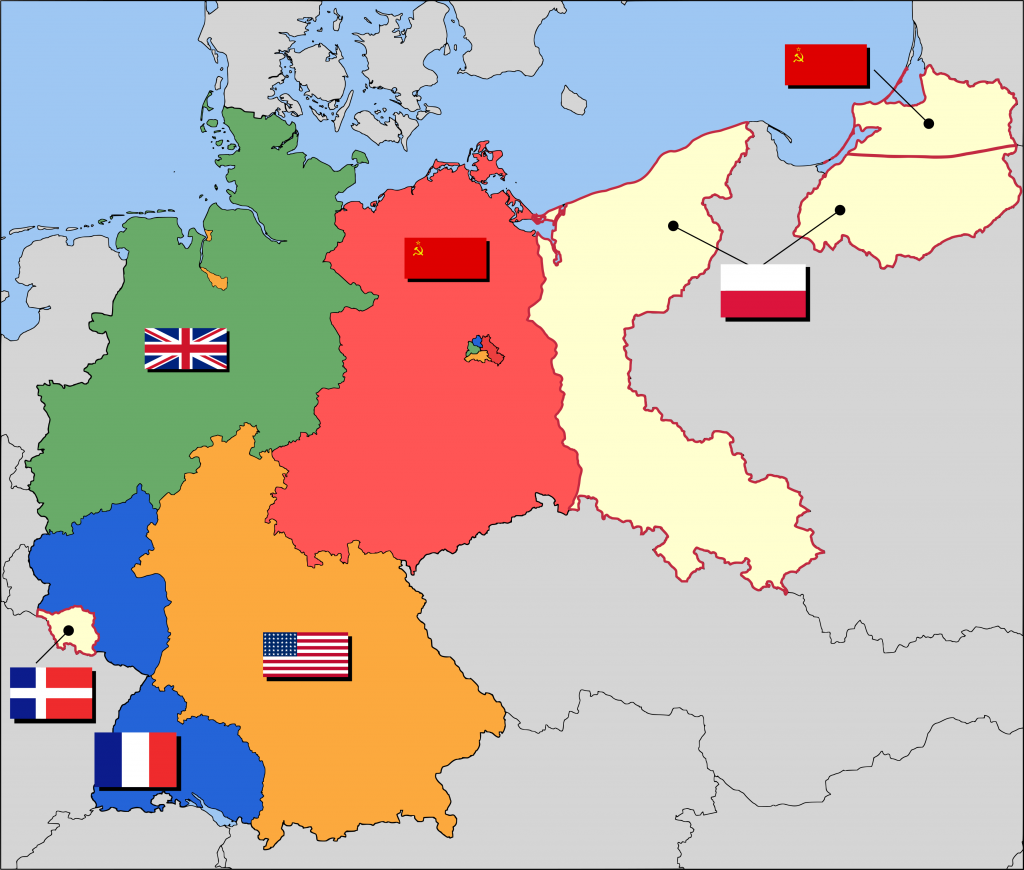Because of the internet in China I am very far behind on my blog posts. This means that today I will be writing about the history of the Berlin Wall, that I visited back on day 47 of our trip. So warning… incoming history.
After WW2 ended, Germany was divided between the victorious allies – the French, British, and Americans on one side and the USSR on the other side. Below is a map of the division of Germany. The difference between the two sides was that the French, British, and Americans wanted to install a democratic government and rebuild the German government, so that they could withdraw from the country and leave a self-sufficient nation. On the other hand, the USSR wanted to install a totalitarian government and have complete control over Germany. Because of this, the two sides split and became East and West Germany.
The difference between the two sides was that the French, British, and Americans wanted to install a democratic government and rebuild the German government, so that they could withdraw from the country and leave a self-sufficient nation. On the other hand, the USSR wanted to install a totalitarian government and have complete control over Germany. Because of this, the two sides split and became East and West Germany. As you can see in the map above, there was a problem. Berlin (the capital city of Germany) was divided along with the rest of the country. East Germany – now a part of the USSR – completely surrounded Berlin, which was divided itself. So it ended up with an island of democracy in a communist ocean. In 1948, in an effort to get the French, British, and Americans out of the city, the USSR instituted a complete blockade of West Berlin. In response to this the Americans started the largest air drop campaign in history.
As you can see in the map above, there was a problem. Berlin (the capital city of Germany) was divided along with the rest of the country. East Germany – now a part of the USSR – completely surrounded Berlin, which was divided itself. So it ended up with an island of democracy in a communist ocean. In 1948, in an effort to get the French, British, and Americans out of the city, the USSR instituted a complete blockade of West Berlin. In response to this the Americans started the largest air drop campaign in history.  For the next year America and Brittan airlifted 5,000 tons of supplies each day into West Berlin (of course the French were on strike), until the USSR finally relented and called off the siege In June of 1949. Relations between the two sides started collapsing. At the time, East Germany was a terrible place to live because of the communist government – it would go on to execute over 250,000 people in East Germany- so people started fleeing the country en-masse. Turns out there was technically another country really close by… in West Berlin. This caused the USSR to build the Berlin Wall in 1961. It started as a simple barbed wire fence but over the next 20 years it would evolve into one of the most formidable defensive lines in history.
For the next year America and Brittan airlifted 5,000 tons of supplies each day into West Berlin (of course the French were on strike), until the USSR finally relented and called off the siege In June of 1949. Relations between the two sides started collapsing. At the time, East Germany was a terrible place to live because of the communist government – it would go on to execute over 250,000 people in East Germany- so people started fleeing the country en-masse. Turns out there was technically another country really close by… in West Berlin. This caused the USSR to build the Berlin Wall in 1961. It started as a simple barbed wire fence but over the next 20 years it would evolve into one of the most formidable defensive lines in history.  To put it in perspective, the Berlin Wall at its height was more fortified than the 38th parallel is today (the border between North and South Korea).
To put it in perspective, the Berlin Wall at its height was more fortified than the 38th parallel is today (the border between North and South Korea).
 In 1987 Ronald Reagan gave his famous Tear Down This Wall speech. In which he said,
In 1987 Ronald Reagan gave his famous Tear Down This Wall speech. In which he said,
“We welcome change and openness; for we believe that freedom and security go together, that the advance of human liberty can only strengthen the cause of world peace. There is one sign the Soviets can make that would be unmistakable, that would advance dramatically the cause of freedom and peace. General Secretary Gorbachev, if you seek peace, if you seek prosperity for the Soviet Union and eastern Europe, if you seek liberalization, come here to this gate. Mr. Gorbachev, open this gate. Mr. Gorbachev, tear down this wall!”
After that Mr. Gorbachev did indeed tear down the Wall. By 1989, free trade and commerce between East and West Germany had reopened. In 1990 Germany reunified into a single democratic country. This, and the collapse of the USSR, helped stop the global spread of communism and furthered the cause of democracy worldwide. Since its reunification in 1990, Germany has grown to once again be the largest economic power in Europe. – CLaff
Instagram @laffertycaleb


This is a very clear and concise explanation about East-and-West Berlin and the partition of Germany, (and the ideologies so intricately connected with this region at
that time).
Question: Are we seeing the calculated return of a new Cold War as Vladimir Putin
was allowed to annex: The Crimean Peninsula, (which was part of the
Ukraine), unopposed? Also, Putin’s forces have been patiently poised
to pounce on Ukraine’s eastern border for the last eighteen months, now.